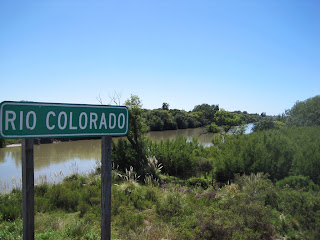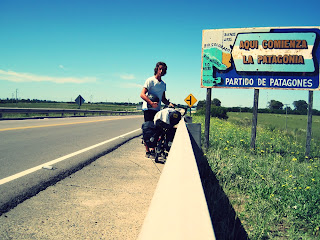On this day there would be no magic in the saddle. I rode back up to Ruta 3 from Puerto Madryn into a steady wind from the southwest, part headwind, part crosswind. It was blowing hard and gusting and I knew that it would be a difficult day.
South of the port was more rolling country and an extended shoulder on the road, but it was rocky and there were many potholes and much loose gravel. It was slow going because of the poor surface and then the wind gathered in strength with huge gusts that blew me back onto the road and into traffic. I was leaning into the wind and waiting for the gusts and it was a challenge to maintain balance on the bike.
After some kilometers I looked to my right and saw another road, newly surfaced, running parallel to Ruta 3. I figured they were preparing to open the road as a newly asphalted Ruta 3. I pushed the bike down and up the gravel embankment separating the roads and now I was fighting the wind on my own 2 lane highway. There were signs saying work was being done and that the road was closed and traffic prohibited, but the trucks of workers only waved me on in encouragement.
The wind strengthened with devastating gusts, and I was riding on my smallest chain ring, dust blowing across the road from the scrub and nearly blinding me. Harder still were the ascents of the hills. I was taking those in my granny gear and barely getting up them. A wind gust would nearly blow the backend out from under you, and near the crests of the hills the wind slammed into you and gusted even harder as you slowly fought your way down the descent. There was no respite from the wind.
I was 35 km out of Trelew when the asphalt of the road running parallel to Ruta 3 ended. It was a gravel now and I pushed the bike back across the embankment to Ruta 3. There was no shoulder now and with the many camions and tour buses I would need to carefully hold the white line on the edge of the asphalt. The gusting crosswind was the wind I feared most and now I would have to ride in it or stop and camp for the night.
A constant wind you can simply lean into, but a gusting crosswind you must lean into in anticipation of the gusts. This leaning poses a real problem for balance, particularly when you are trying to ride a sliver of pavement to the right of the white line marking the side of the highway. Because too much leaning can also cause your tires to slip off the pavement into the gravel, wedge against the side of the pavement in the stones, and topple the rider from his bicycle, potentially back onto the road into traffic.
The best way to ride into this wind was to get as low as possible on the bike, riding in the drops, head near the handlebars, and to peddle a larger gear slowly to minimize movement and maintain balance. Then, when I saw oncoming traffic, and recognized there would be little room for a camion or tour bus coming up from behind to pass, I would dive off the road onto the gravel banquina. You could not risk a big gust sending you into the side of a truck or tour bus as it passed. The wind streams of the passing large vehicles also pulled you towards them before propelling you forward.

I rode carefully with much driving off into the gravel and then at the top of a group of hills I could see Trelew in the valley, and behind it white cliffs. I would have a long descent through the wind to get there and I started down, grinding it out in my smallest chain ring and holding the white line, and listening for trucks and buses behind me. My wrists and elbows ached from the extended period in the drops but it was the safest way to ride and I did not stop until the petrol station outside the city.

I had a 1.5 liter bottle of sparkling water and checked my notes on Trelew. There was a campground 7 km out of town on RN 7. I rode into the center of town and bought cheese, pasta sauce, apples, milk and cookies at a supermercado. It was a tired, beat up town and not attractive in any way and when I walked out the super market it was dark, and huge gusts of wind blew dust and debris through the streets. I hung the sacks of food over the handlebars and started slowly through the wind and out of city.
At the rotunda on the edge of town I turned onto RN 7 and had the wind at my back, blowing a gale and blasting me down the road. I was being carried along and did not need to peddle and looked left and right for the campground. I saw nothing and exhausted and I had no idea how far I had gone, and then I saw signs indicating I was almost to Rawson, a small town on the coast. I had missed the campground. But to turn back into the wind would be a disaster. I could not do it. I let the wind carry me into Rawson thinking I would find a campground or balneario there.
A man told me there was a campground another 8 km from the centro. I had the wind as a crosswind and rode on a bike path along a larger road towards the sea. I entered a grittier area of partially built homes and windswept scrub and open dirt spaces. There was a girl on a bicycle in a bright pink shirt and listening to music on earphones and I stopped her asked her where I could find the campground. She smiled and told me to follow her.
She road off the paved bike path and down the dirt and large stone side streets back into a housing development and I followed. But my bike began to sink down into the large stones and I would need to push it out. The girl in pink was getting further ahead of me. She rode slowly on a commuter bike with large tires that kept her from sinking into the stones and sand. I would try to catch up to her but would hit a patch of large stones and nearly fall off the bike. She was too far ahead now to hear her singing and I called out to her but she did not turn back. I just caught a glimpse of her as she made a turn a few blocks ahead of me and then I sunk again into the stones and when I pushed the bike out I had lost her. I was lost in some partially built subdivision on roads that were hardly passable. I cursed my bad luck.
But the girl in pink rode back for me. She had a big smile on her face and pointed to a white gateway on the next block. It was the campground. I thanked her and pulled in and met an old man named Mario who ran the place and he spoke to me a long time, mostly about American politics, and then I put my tent up. I cooked up the pasta I had purchased and drank the beer that was still cold and I felt very tired. I had no idea where I was and I would figure it out tomorrow.




















































